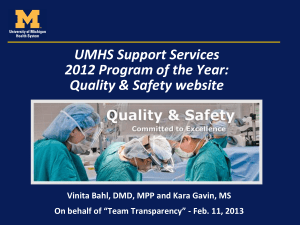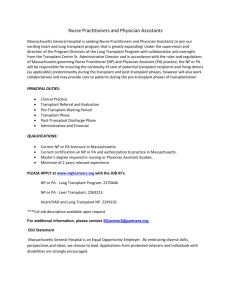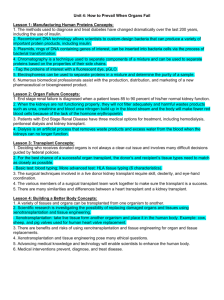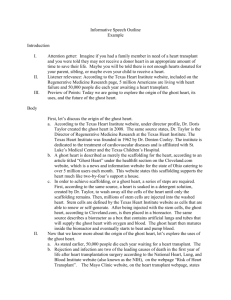Persuasive Speech Example Two
advertisement
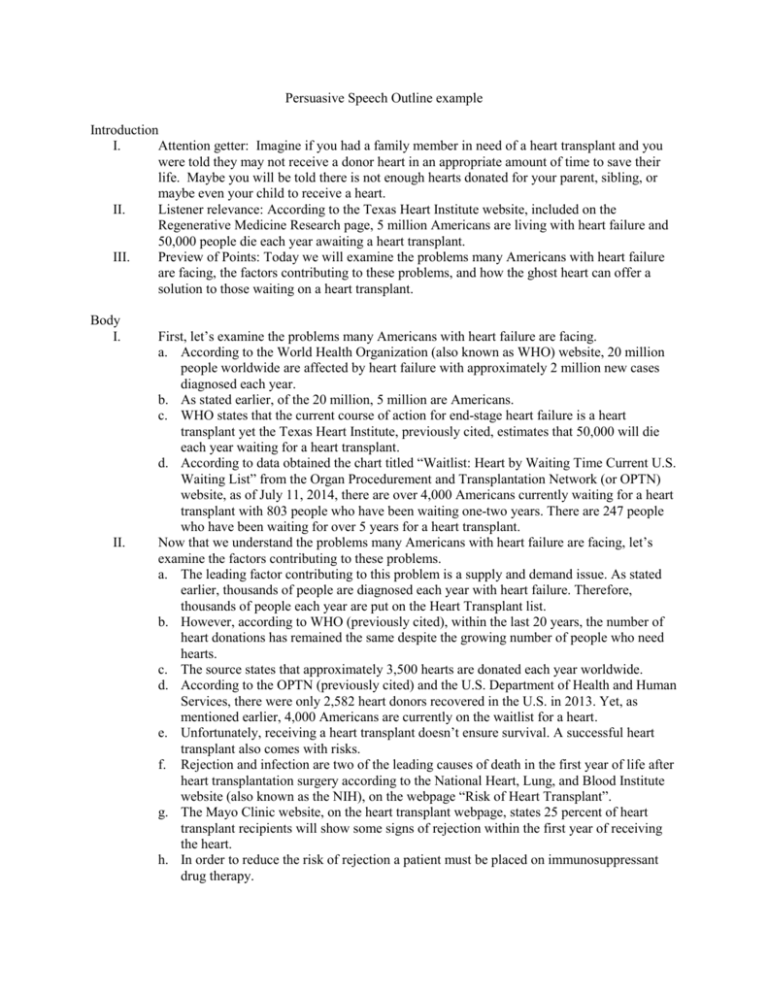
Persuasive Speech Outline example Introduction I. Attention getter: Imagine if you had a family member in need of a heart transplant and you were told they may not receive a donor heart in an appropriate amount of time to save their life. Maybe you will be told there is not enough hearts donated for your parent, sibling, or maybe even your child to receive a heart. II. Listener relevance: According to the Texas Heart Institute website, included on the Regenerative Medicine Research page, 5 million Americans are living with heart failure and 50,000 people die each year awaiting a heart transplant. III. Preview of Points: Today we will examine the problems many Americans with heart failure are facing, the factors contributing to these problems, and how the ghost heart can offer a solution to those waiting on a heart transplant. Body I. II. First, let’s examine the problems many Americans with heart failure are facing. a. According to the World Health Organization (also known as WHO) website, 20 million people worldwide are affected by heart failure with approximately 2 million new cases diagnosed each year. b. As stated earlier, of the 20 million, 5 million are Americans. c. WHO states that the current course of action for end-stage heart failure is a heart transplant yet the Texas Heart Institute, previously cited, estimates that 50,000 will die each year waiting for a heart transplant. d. According to data obtained the chart titled “Waitlist: Heart by Waiting Time Current U.S. Waiting List” from the Organ Procedurement and Transplantation Network (or OPTN) website, as of July 11, 2014, there are over 4,000 Americans currently waiting for a heart transplant with 803 people who have been waiting one-two years. There are 247 people who have been waiting for over 5 years for a heart transplant. Now that we understand the problems many Americans with heart failure are facing, let’s examine the factors contributing to these problems. a. The leading factor contributing to this problem is a supply and demand issue. As stated earlier, thousands of people are diagnosed each year with heart failure. Therefore, thousands of people each year are put on the Heart Transplant list. b. However, according to WHO (previously cited), within the last 20 years, the number of heart donations has remained the same despite the growing number of people who need hearts. c. The source states that approximately 3,500 hearts are donated each year worldwide. d. According to the OPTN (previously cited) and the U.S. Department of Health and Human Services, there were only 2,582 heart donors recovered in the U.S. in 2013. Yet, as mentioned earlier, 4,000 Americans are currently on the waitlist for a heart. e. Unfortunately, receiving a heart transplant doesn’t ensure survival. A successful heart transplant also comes with risks. f. Rejection and infection are two of the leading causes of death in the first year of life after heart transplantation surgery according to the National Heart, Lung, and Blood Institute website (also known as the NIH), on the webpage “Risk of Heart Transplant”. g. The Mayo Clinic website, on the heart transplant webpage, states 25 percent of heart transplant recipients will show some signs of rejection within the first year of receiving the heart. h. In order to reduce the risk of rejection a patient must be placed on immunosuppressant drug therapy. i. III. The NIH further states the risk factors and side effects from immunosuppressant drug therapy. j. According to the NIH, cancer, kidney damage, and infections can result from immunosuppressant drug therapy. Finally, after better understanding the problems many Americans with heart failure are facing and the factors contributing to these problems, let’s explore how the ghost heart can offer a solution to those waiting on a heart transplant. a. According to the article on the Cleveland.com website, previously cited, the use of the ghost heart could eliminate the need for anti-rejection medicines and their negative side effects. b. A ghost heart is described as merely the scaffolding for the heart, according to an article titled “Ghost Heart” under the healthfit section on the Cleveland.com website, which is a news and information website for the state of Ohio catering to over 5 million users each month. This website states this scaffolding supports the heart much like two-by-four’s support a house. c. In order to achieve scaffolding, or a ghost heart, a series of steps are required. First, according to the same source, a heart is soaked in a detergent solution, created by Dr. Taylor, to wash away all the cells of the heart until only the scaffolding remains. Then, millions of stem cells are injected into the washed heart. Stem cells are defined by the Texas Heart Institute website as cells that are able to renew or self-generate. After being injected with the stem cells, the ghost heart, according to Cleveland.com, is then placed in a bioreactor. The same source describes a bioreactor as a box that contains artificial lungs and tubes that will supply the ghost heart with oxygen and blood. The ghost heart then matures inside the bioreactor and eventually starts to beat and pump blood. d. According to the NIH, researchers believe the ghost heart will not be rejected because the heart will be custom made from the recipient’s stem cells. e. In other words, if the patient’s own cells are being used to create the new heart, then the recipient’s body will not attack these cells. Conclusion I. Signal Conclusion / Review Points: In conclusion, we have examined the problems many Americans with heart failure are facing, the factors contributing to these problems, and how the ghost heart can offer a solution to those waiting on a heart transplant. II. The creation of a functioning ghost heart will provide many more hearts available for transplant. Additionally, it will also eliminate the need for drug therapy after receiving a donor heart. III. Clincher: Increasing the amount of available transplantable hearts will possibly eliminate some of the 50,000 deaths that occur each year while awaiting a heart transplant.


